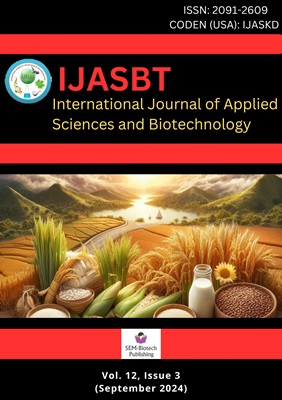Screening of in-vitro Biofilm Production by Bacterial Pathogens Isolated from Secondary Hospital Waste-water and their Antibiotic Susceptibility Pattern
DOI:
https://doi.org/10.3126/ijasbt.v12i3.70156Keywords:
Biofilm, secondary hospital, wastewater, Congo Red Agar, Disk Diffusion methodAbstract
Objective: The main objective is to screen the in-vitro Biofilm Production by Bacterial Pathogens isolated from Secondary Hospital Wastewater and their Antibiotic Susceptibility Pattern.
Methods: A total of 10 hospital wastewater samples were collected within 3 consecutive days from a secondary hospital and research was carried out in the microbiological laboratory of D.A.V. College. Identification was done by performing Gram-staining followed by conventional biochemical tests. Screening of in-vitro biofilm production was done using the Congo Red Agar (CRA) method. Antibiotic Susceptibility Pattern (AST) was performed on Mueller-Hinton Agar (MHA) media by the Kirby-Bauer Disk Diffusion Method as per CLSI guidelines.
Results: A total of 25 bacterial isolates were identified during the identification process. Among all bacterial isolates, 12 (48%) were screened as biofilm producers, with dry crystalline black-centered colonies. In contrast, the remaining 13 (52%) were screened as non-biofilm producers with pink colonies. Escherichia coli (66.6%), were the most common biofilm-producing Gram-negative bacilli followed by Citrobacter freundii (16.66%), Enterobacter spp (8.37%), Morganella morganii (8.37%). During the antibiotic susceptibility pattern, a total of 16 (64%) bacterial isolates were recognized as Multidrug-resistant (MDR), and the remaining 9 (36%) were recognized as non-MDR.
Conclusion: The overall result showed that both MDR and non-MDR bacteria can form biofilms. However, Antimicrobial resistance patterns were observed higher in MDR biofilm producers than in non-MDR biofilm producers.
Int. J. Appl. Sci. Biotechnol. Vol 12(3): 145-150.
Downloads
Downloads
Published
How to Cite
Issue
Section
License
Copyright (c) 2024 International Journal of Applied Sciences and Biotechnology

This work is licensed under a Creative Commons Attribution-NonCommercial 4.0 International License.




